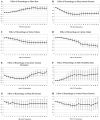Hemodynamic Effects of Cardiovascular Medications in a Normovolemic and Hemorrhaged Yorkshire-cross Swine Model
- PMID: 34876241
- PMCID: PMC8915414
- DOI: 10.30802/AALAS-CM-21-000080
Hemodynamic Effects of Cardiovascular Medications in a Normovolemic and Hemorrhaged Yorkshire-cross Swine Model
Abstract
The Yorkshire-cross swine model is a valuable translational model commonly used to study cardiovascular physiology and response to insult. Although the effects of vasoactive medications have been well described in healthy swine, the effects of these medications during hemorrhagic shock are less studied. In this study, we sought to expand the utility of the swine model by characterizing the hemodynamic changes that occurred after the administration of commonly available vasoactive medications during euvolemic and hypovolemic states. To this end, we anesthetized and established femoral arterial, central venous, and pulmonary arterial access in 15 juvenile Yorkshire-cross pigs. The pigs then received a series of rapidly metabolized but highly vasoactive medications in a standard dosing sequence. After completion of this sequence, each pig underwent a 30-mL/kg hemorrhage over 10 min, and the standard dosing sequence was repeated. We then used standard sta- tistical techniques to compare the effects of these vasoactive medications on a variety of hemodynamic parameters between the euvolemic and hemorrhagic states. All subjects completed the study protocol. The responses in the hemorrhagic state were often attenuated or even opposite of those in the euvolemic state. For example, phenylephrine decreased the mean arterial blood pressure during the euvolemic state but increased it in the hemorrhagic state. These results clarify previously poorly defined responses to commonly used vasoactive agents during the hemorrhagic state in swine. Our findings also demonstrate the need to consider the complex and dynamic physiologic state of hemorrhage when anticipating the effects of vasoactive drugs and planning study protocols.
Figures


Similar articles
-
A continuous hemorrhage model of fatal hemorrhagic shock in swine.Resuscitation. 1989 Jun;17(3):287-95. doi: 10.1016/0300-9572(89)90044-0. Resuscitation. 1989. PMID: 2548273
-
Dextran concentrations in plasma and urine following administration of 6% dextran-70/7.5% NaCl to hemorrhaged and euvolemic conscious swine.Circ Shock. 1989 Dec;29(4):301-10. Circ Shock. 1989. PMID: 2480855
-
Small-volume resuscitation with HBOC-201: effects on cardiovascular parameters and brain tissue oxygen tension in an out-of-hospital model of hemorrhage in swine.Acad Emerg Med. 2002 Oct;9(10):969-76. doi: 10.1111/j.1553-2712.2002.tb02127.x. Acad Emerg Med. 2002. PMID: 12359531
-
A prospective, randomized trial of intravenous hydroxocobalamin versus whole blood transfusion compared to no treatment for Class III hemorrhagic shock resuscitation in a prehospital swine model.Acad Emerg Med. 2015 Mar;22(3):321-30. doi: 10.1111/acem.12605. Epub 2015 Mar 2. Acad Emerg Med. 2015. PMID: 25731610
-
Vasopressin decreases pulmonary-to-systemic vascular resistance ratio in a porcine model of severe hemorrhagic shock.Shock. 2015 May;43(5):475-82. doi: 10.1097/SHK.0000000000000325. Shock. 2015. PMID: 25565637
References
-
- Bilello JF, O’Hair KC, Kirby WC, Moore JW. 1991. Intraosseous infusion of dobutamine and isoproterenol. Am J Dis Child 145:165–167. - PubMed
-
- Britz GW, Tomas J, Lumsden A. 2020. Feasibility of robotic-assisted neurovascular interventions: initial experience in flow model and porcine model. Neurosurgery 86:309–314. - PubMed
-
- Carrara M, Babini G, Baselli G, Ristagno G, Pastorelli R, Brunelli L, Ferrario M. 2018. Blood pressure variability, heart functionality, and left ventricular tissue alterations in a protocol of severe hemorrhagic shock and resuscitation. J Appl Physiol 125:1011–1020. 10.1152/japplphysiol.00348.2018. - DOI - PMC - PubMed
-
- Chalkias A, Koutsovasilis A, Laou E, Papalois A, Xanthos T. 2020. Measurement of mean systemic filling pressure after severe hemorrhagic shock in swine anesthetized with propofol-based total intravenous anesthesia: implications for vasopressor-free resuscitation. Acute Crit Care 35:93–101. 10.4266/acc.2019.00773. - DOI - PMC - PubMed
MeSH terms
LinkOut - more resources
Full Text Sources

